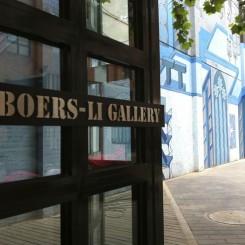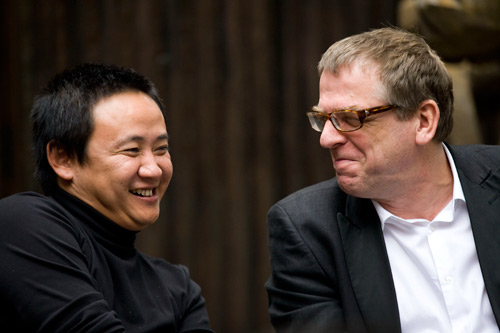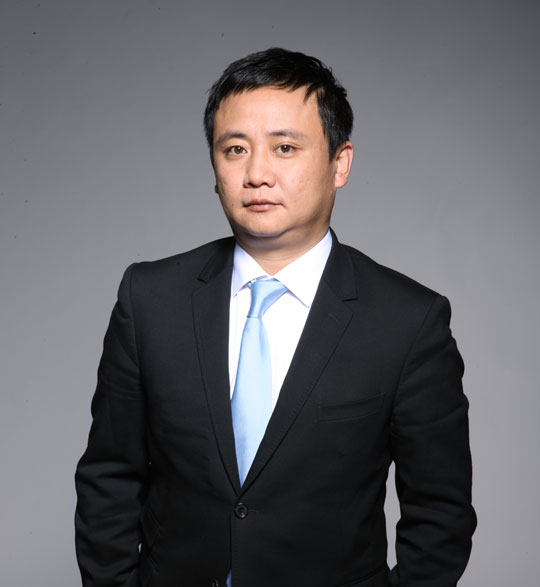Pi Li and Waling Boers represented one of the most successful curatorial and gallerist partnerships China has yet seen, establishing the non-profit Universal Studios in 2005, which subsequently metamorphosed into Boers Li Gallery. Last year, it was announced that Pi Li was to become Senior Curator for M+, the future Museum of Visual Culture in West Kowloon Cultural District, Hong Kong.
Note: This interview was conducted prior to the announcement that Pi Li would leave the gallery and his teaching position at the Central Academy of Fina Art (CAFA) in Beijing in order to join M+ in Hong Kong. This information was omitted when the article was originally published on April 17.
Chris Moore: I want to start off by asking you about your respective backgrounds — where you grew up, and what was your introduction to art?
Waling Boers: That was some time ago. And I can’t really remember. It was a slow process. I didn’t know exactly what “art” was. You like things and you don’t like things. You go after the things you like and, before you know it, you are surrounded by things that you don’t really know if people will even call “art.” So, at a certain moment, people say “hey, what are you doing?” and I say, “Well, I’m making exhibitions.” And that’s how it started. I was interested in visual culture and was involved in some projects and gradually I became more professional and I saw it as something to go after.
Pi Li: Oh God! Are you finished? [Waling guffaws] My story’s quite simple. My father was a professor of art history and because I grew up in the 1980s, art was art was around me all the time and so I grew up in that kind of environment. Then I went to college, and studied art history.
CM: How did you both meet?
PL: We first met when we were introduced, in Dongming market in Shenzhen. We were introduced to each other — before that Waling was here several times. Hou Hanru told me that there was this strange guy here, a German who had come for research. We were curating a show in Shenzhen and decided to ask Waling to join the symposium. And then we met.
CM: And how did it develop from there?
WB: Well, initially it was just talking, thinking maybe it would be interesting to do something together. I had a not-for-profit gallery in Berlin and people would tell me that they wanted to have something like this in China as well. I was a little skeptical because I knew the funding was coming from state organizations (Dutch, German, British, French etc.). I didn’t see any realistic opportunities to work in China with the State in a non-profit scenario — as an NGO. But we kept talking, and it became more and more interesting to think about a set-up. And in 2005 it was time to make a decision — yes or no — so we started and found a place and then it was kind of real. Although we still don’t know if it’s really real!
PL: There was a booming market in China but there was no good environment for artists at that time. So I said, “Good! Then let’s make a not-for-profit space!” After several months though, after opening the space in 2005, we found it so difficult. That’s why the former name for Boers Li Gallery, Universal Studios Beijing, is quite a “not-for-profit” name, an institutional name — because it covers everything.
CM: At least for people in the West it also reminds them of the name of the famous Hollywood studio.
WB: Are you sure?! Oh, we didn’t know that! (laughing, lots). [Pi Li was producer of the Cannes prize-winning film “Shanghai Dreams,” 2005] We were just playing with names and combinations lent from the West and we had this feeling of something universal, something big and spacious. The combination “Universal” and “Studios” was interesting because we wanted to work very closely with artists, with young artists’ productions and nor being restricted to the East or the West. So “Universal Studios” — a global-oriented concept. (1) We knew from the beginning that we would confront some legal …“readjustments”! But for the time being it was interesting to have this name. And as you would expect, after a while there were some lawyers knocking on the door asking what we had in mind with this name, and at that moment we were already discussing among ourselves changing from not-for-profit to another kind of model.
So the two things came together. We also didn’t want to be so “blurry” as to represent ourselves as being a not-for-profit environment although we were necessarily strongly commercial in the background. But it was a little bit confronting for us ex-curators to have the word “gallery” in the name — very classically oriented, but it was also an opportunity to concentrate on just one aspect of “Universal Studios.”
CM: Pi Li, before you ever became a gallerist you were a noted curator and art critic. Colin Chinnery once said to me, only half-jokingly, that in the end there are really only two jobs in China for people interested in art: artist or gallerist. What do you think of that?
PL: No, I wouldn’t say that! Officially I am still teaching at CAFA. But for me to be a gallerist is more of a challenge, I have to say. The main reason I came to work with Waling in 2005 was my feeling of having failed when I worked on that “Allôrs la Chine” show [in the Centre Georges Pompidou, Paris, in 2003] together with the Ministry of Culture of France. In 2003 the Chinese government changed quite a lot. They wanted contemporary art to be involved in the national “adage.” So we created quite a lot of shows — the Venice Biennial, the Centre Pompidou. And I felt quite hurt, because for the Chinese people they only wanted to show the things they wanted to see in contemporary art, and the foreigners are hungry but they only want to show the contemporary Chinese art that they can understand, without challenges. So every time you write a proposal, you correct it, you have to negotiate it with the government, and you have to negotiate with the so-called “creators.”
CM: How do you both define Boers Li gallery? How would you characterize it and your practice?
PL: First of all, Boers Li is a very strange construction. Now I know that we are the only gallery with two partners, one Chinese, one foreign. If you go to any other gallery, you see that they are either only Chinese or only foreign — so two different partners, two different cultures. But that also caused an identity problem, for me too. First of all, for some collectors or some fairs, we are not so Chinese and then for some Chinese collectors they say we are too academic, too far from the regular model, so we are really in the middle ground. First of all, we are not just working with a certain category of artists. And secondly, we are not “dealing” in art, that is, working in the secondary market, showing only the most saleable things. So artists like Zhang Peili, the first video artist — who is from the older generation —
WB: — Be careful: I am older than him!
PL: And Zhang Wei, probably the same age, but who practices in painting. Then there are young artists like Yang Xinguang, quite conceptual, alongside artists like Chen Yujun, with a contemporary-traditional style of painting.
CM: On the one side, you have to manage the expectations of young artists and on the other, you have a market that is perhaps more speculative than in the West. So where is the Chinese art market now with regard to these particular problems, how is it developing?
PL: I think the main thing for China, no, I think for the whole art market — the collecting culture — is about the “advantages” as well [of collecting art], [like] the middle class supporting Impressionism and Americans supporting Abstract Expressionism. In China, we have the money [to collect] but we don’t have the same strong background as collectors. I think it is very hard for collectors to identify for themselves what they want. Most collectors in China are developing very fast but during the recent period they were just buying, buying — I mean, in the beginning, I am sorry to say, they were really buying by…
WB: — year by year or day by day — without historical or continuous perspective.
PL: — yes, day by day. So that’s really hard for a gallery like us because we are really communicating with taste; we are not communicating with the sales price. Though the Chinese market is strong, we are also slow. The art market growth in the past three to four years has been amazing, but it was mainly in traditional Chinese art. Last year traditional Chinese art, antiques, occupied 63% [of the market], and ink wash occupied around 30%. In the West, painting from the fourteenth, fifteenth and sixteenth centuries, has [largely] already been donated to museums for a long time. There is no recycling in the market. So the market in China is so big, but in fact most of the money goes to this kind of historical, museum level [art] — so there is not so much space for contemporary art.
References
Rob Hamelijnck and Nienke Terpsma (editors), “BüroFriedrich. Fucking Good Art in conversation with Waling Boers in the Münzeclub”, FGA#12 — International edition / Berlin, March 2006), pp. 12-19.
Pi Li was born in 1974 in Wuhan. His father was a professor of art history. After graduating from CAFA in 1996, he worked for a short time at the Courtyard Gallery, Beijing’s first commercial art gallery, and also became a well-known art critic. Since 2001 he has taught in the Department of Art Administration at CAFA. In 2009 he received his doctorate in art theory from CAFA, studying under Professor Wang Hongjian. Pi Li has also assisted with curating numerous important exhibitions, including in 2002 the Sao Paulo and Shanghai biennales, in 2003 “Allôrs la Chine” at the Pompidou Centre, France, and in 2006 — in collaboration with Waling Boers — the influential “China Power Station” exhibition at Battersea Power Station organized by the Serpentine Gallery in London. In June 2012, he left Boers Li Gallery to take up his new post as senior curator at M+ in Hong Kong.
Waling Boers was born in 1954 in the Netherlands. He has a M.A. degree in Social Science and Art History from the University of Amsterdam. He was editor in chief of an art magazine Code, freelance art critic, teacher of art and curator, contributing to art institutions like Stedelijk Museum Amsterdam, Hamburger Bahnhof Berlin, Berlin Biennale Berlin 2 and Dutch and German governmental institutions. In late-1997 Waling Boers established the non-profit art space BüroFriedrich, in the Mitte district of East Berlin, an area now synonymous with upscale galleries, restaurants and offices. Operative until 2005 and funded by diverse governmental sources, he introduced a number of prominent Chinese artists to the European art world, among them Yang Fudong, Zhang Enli, Cao Fei and Xu Tan. In 2006 he was editor of a book on Chinese art, Touching the Stones — China Art Now, published by Walther Koenig.






